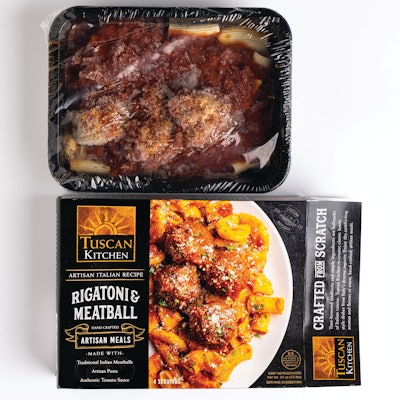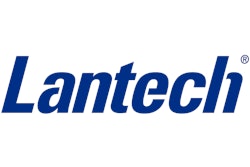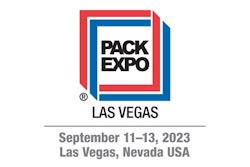
Described by some as a serial food entrepreneur, Joe Faro got his start at his parents’ corner bakery when he was just a child. Fresh out of the University of New Hampshire, he launched Joseph’s Gourmet Pasta and Sauces, which he sold in 2006 to the Buitoni division of Nestlé Prepared Foods. He then went on to establish numerous restaurants and catering services that now serve up Italian specialties and a whole lot more throughout the New England area.
This story is about the newest development in Faro’s Salem, N.H.-based Tuscan Brands empire: Artisan Chef Manufacturing Co. The Lawrence, Mass.-based facility is producing and packaging restaurant-quality Italian style foods for distribution in much of the country through supermarket chains like Market Basket and club stores like BJ’s Wholesale Club and Costco. Two new lines currently operating in the Lawrence plant include one for ready meals and one for ravioli, those little pasta envelopes containing delicious mixtures of ground meat, cheese, or vegetables. Both lines are worth a look, beginning with the ready meals line that produces a variety of items sold refrigerated or frozen in premade trays thermoformed of crystallized PET (CPET).
“Flexibility is the key, because in addition to depositing our cooked pasta, we want to apply a variety of sauces, add different kinds of protein, add various cheeses, all those types of things—and all in-line,” says Faro. A key resource was Orics Industries and Orics president Ori Cohen. “He’s so good at entering a food manufacturing factory, recognizing the needs, and creating packaging equipment that is more or less customized just for you,” says Faro. When asked if that kind of customization comes with a hefty price tag, Faro says not really. “It’s not the least expensive machinery, but perhaps more important is that I enjoy working with Ori partly because he’ll design a piece of equipment for your process rather than having us design our process around his equipment. He’ll even modify the line after it’s in if need be, which is important because when you’re customizing equipment, things may not always be perfect the first time around.” On the ready meals line, the first bucket elevator delivers pasta up to a combination scale while the second bucket elevator/scale combo is for pieces of beef, shrimp, or chicken.
On the ready meals line, the first bucket elevator delivers pasta up to a combination scale while the second bucket elevator/scale combo is for pieces of beef, shrimp, or chicken.
It isn’t just the product going into the trays that fluctuates on this ready meals line. The CPET trays, supplied by Amcor, vary as well. In addition to a single-serve meal in a tray measuring 6 x 8 in., the firm also offers a multi-serve portion in a tray measuring 12 x 8 in. The servo-driven TV 1000 tray denester from Orics handles both tray formats, dropping trays single-file onto a stainless steel lugged conveyor that indexes them forward. Also worth noting upstream from this screw denester is an Orics automatic denester loader that holds almost 40 minutes worth of trays.
The first product to be deposited into the tray is pasta, which is fed by a 14-bucket combination scale from Smart Weight Packaging System Ltd., a Chinese OEM represented in the U.S. by Orics. The freshly made pasta is delivered to the overhead scale by way of an Orics incline bucket elevator. The scale selects the right combination of buckets for the weight that’s called for and those buckets drop their contents into two memory buckets. When two trays arrive in the correct position, they pause and the memory buckets open to drop their contents into the trays. Helping to cleanly guide the pasta into the trays with no chance for spillage are two funnels that stroke down into the tray just before the memory buckets open. The servo-driven tray denester on the ready meals line handles two tray sizes, dropping trays single-file onto a stainless steel lugged conveyor that indexes them forward.
The servo-driven tray denester on the ready meals line handles two tray sizes, dropping trays single-file onto a stainless steel lugged conveyor that indexes them forward.
“Orics has a proprietary relationship with the Chinese manufacturer of the scale and actually puts the finishing touches on it, not to mention all the controls,” says Faro. “So it’s practically an Orics machine, and they’ve done an excellent job with it. We now have three of them and another one coming. We use them for everything from pasta to vegetables to grilled chicken strips to grilled shrimp to meatballs.”
Second combination scale
Next in line is a second 14-head combination scale that deposits small pieces of cooked protein such as chicken, shrimp, or beef. It’s also fed by an Orics incline bucket elevator that takes product from a floor-level hopper up to the overhead level.
Now it’s time for sauce, which is deposited by an Orics volumetric piston filler. The sauce is delivered from a holding tank to an overhead hopper and then down into four nozzles, two for each tray. Trays pause and sauce is deposited.
The next piece of equipment in the line, though it isn’t used for every product, is a waterfall grated cheese depositor from Quantum Topping Systems. The trays then move ahead to an Ilapak Delta 3000 shrink film flow wrapper. The PC-controlled machine features Ilapak’s unique high-speed hermetic sealing technologies and is equipped with long-dwell technology for modified atmosphere packaging (MAP).
“It’s a commonly used solution for modified atmosphere packaging,” says Faro. “Its gas lances go all the way down the forming tube, and it creates kind of a Venturi that pushes the oxygen out and replaces it with a nitrogen/oxygen atmosphere.” This photo, shot at the Orics facility before equipment was shipped to Artisan Chef, shows the alignment of the four pumps that deposit sauce onto pasta on the ready meals line.
This photo, shot at the Orics facility before equipment was shipped to Artisan Chef, shows the alignment of the four pumps that deposit sauce onto pasta on the ready meals line.
The flow wrap film that runs on the Ilapak, supplied by Sealed Air, is Cryovac brand BDF-2060, a multilayered coextruded shrink film formulated with anti-fog as well as both oxygen and aroma barrier properties. Says Faro, “It’s a very good solution for us for both refrigerated and frozen formats.”
Exiting the Ilapak flow wrapper, trays enter one of three Tecnopool spiral coolers. For customers who want to receive frozen product, where shelf life is nine months to a year, the spiral cooler temperatures are set accordingly. For retailers who prefer fresh refrigerated product with a shelf life of 25 days, again the cooling temperature is set accordingly. Just downstream from each spiral cooler is a cartoner—one is a Langen cartoner from Mpac Group, one is from Econocorp, and the third is from ADCO. Frozen trays, whether single-serve or multi-serve, go into a carton. Downstream from all three cartoners, cartons are manually placed into corrugated cases that are erected on a Lantech case erector. Both 6- and 12-count cases are done.
Unlike frozen product, the fresh refrigerated trays do not get individual cartons. Instead, they go into a corrugated case also erected on the Lantech case erector. Multi-serve trays are four per case, single serve are six. These fresh refrigerated trays get weighed and labeled by the retailer, an approach that brings with it a “fresh from our in-house deli” kind of message. This photo shows the pumps in action at Artisan Chef.
This photo shows the pumps in action at Artisan Chef.
As for the cost of the prepared meals, it ranges widely depending on ingredients. But a tray of Rigatoni and Meatball holding four servings with a net weight of 24 oz is $10.99, and two trays of Italian Style Shrimp Scampi holding four servings each with a net weight of 40 oz costs $18.99.
“The prepared meal line runs either tray size somewhere around 60 trays a minute,” says Faro. “It also gives us an option for continuous motion, but we’ve realized intermittent motion works best because that way we maintain firmer control over everything. Filling two trays per cycle, it’s around 30 cycles a minute, which is an efficient and comfortable speed. We’re pleased with the solution Orics provided. It was all a matter of looking at the variety of items we wanted to put into these trays—whether it be meatballs or chicken or vegetables or pasta or sauce or shrimp or whatever—and then automating those processes so that we’re able to put a lot of product out the door without having too much manual labor.”
Ravioli includes in-line thermoforming
Now let’s move to the ravioli line, which substitutes a Harpak-Ulma roll-fed thermoforming system for premade trays. Why thermoforming rather than premade trays for these products? According to Faro, it’s an established format for this style of pasta in both the retail supermarket and club store channels. “So it made sense for us to go this route,” he adds. The upstream thermoformer on the ravioli line sends formed trays into the filling station two across. But a servo-driven shuttle system combined with a divider makes it possible to fill four memory buckets at a time, so filling is done four-up.
The upstream thermoformer on the ravioli line sends formed trays into the filling station two across. But a servo-driven shuttle system combined with a divider makes it possible to fill four memory buckets at a time, so filling is done four-up.
The multilayer roll-fed forming web fed into the thermoformer is Ecoblock from Evertis. Packages are formed two-across and depth of draw varies widely, but maximum is 3 in. After undergoing pasteurizing and drying, the ravioli is conveyed to an Orics bucket incline conveyor that takes it up to a 14-head combination scale similar to the two on the ready meals line. Thermoformed trays are indexed two-across into the filling station beneath the combination scale, but filling is done four per cycle. “We integrated a servo-driven shuttle system and a divider that lets us fill four memory buckets at a time,” says Orics’ Cohen. “So with every two cycles of the thermoformer, our machine cycles once.”
“This shuttle system is another example of the custom design solutions that we got from Orics,” says Faro. “We have very thin artisanal ravioli, and they were able to design something that operated at an acceptable pace but didn’t break the edges and was very gentle on the product . That was very important to us.”
After ambient air is evacuated and the package is backflushed with inert gas, the trays have heat-sealed to them a Veritiv multilayer lamination offering both oxygen and aroma barrier properties. Then they pass through a Linx ink-jet coder that puts date code and use-by dates on the lidding material. Next a pressure-sensitive labeler from Diagraph applies a label to the top and bottom of the package. Then they go through a foreign-object detector from Sesotec and finally go into a spiral cooler. Like the ready meals, the ravioli can be sent to customers either frozen or fresh. And those customers can display the product in the frozen cabinet or they can slack it out and display it in the refrigerated case. Whether it leaves Artisan Chef frozen or refrigerated, secondary packaging involves manual insertion of packs into corrugated cases erected by a Lantech case erector.  Tuscan Kitchen brand 7-oz ravioli packs.
Tuscan Kitchen brand 7-oz ravioli packs.
With a little more than a year’s worth of production under their belts on both the ready meals and the ravioli lines, Faro and colleagues are pleased with them from an operational standpoint. Worth noting is that they’re not done upgrading and automating yet. In the works is a system that includes an Orics delta-style robot that will pick and place sheets of lasagna dough. So it will be a matter of placing a sheet of dough in a preformed CPET tray, pumping sauce in, then placing another sheet of dough on top of the sauce, and then pumping another sauce, and so on until the tray has multiple layers of dough and multiple layers of ingredients, including shredded cheese—all done by automated systems. Key to this development is a specialized vacuum suction cup that makes it possible to pick a piece of lasagna dough from a conveyor belt. PW
























